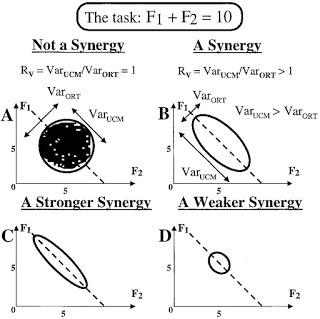This fact - that the action system contains more elements than are needed to solve a given task - was first formalised by Bernstein as the degrees of freedom problem. Anything that can change state is a degree of freedom that can contribute to movement stability and if you have more than you need then there is immediately more than one way to perform a task. This means you have to select the best action, and even then there are always variations in the details of how you perform that action (Bernstein called this 'repetition without repetition'). From this perspective, selecting the right action means freezing out redundant degrees of freedom and working with just the ones you need.
A more recent way to think about the problem is as the bliss of motor abundance (Gelfand & Latash, 1998; Latash, 2012; see this recent post too). From this perspective, selecting the right action is about balancing the contributions of all the degrees of freedom so that the overall behavior of the system produces the required outcome. Nothing is frozen out, but errors incurred by one degree of freedom are compensated for by changes in other degrees of freedom. If (and only if) this compensation happens, then you have a synergy in action.
This analysis leads to a prediction and an analysis. It predicts that there are two kinds of movement variability - variability that pulls you away from your target state and variability that doesn't. The former is a problem that must be corrected by another element in the synergy compensating. Successful movement requires clamping down on this variability. The latter requires no correction, no control, and successful movements can still happen even if this variability is high. An analysis of movement then follows. You can decompose the variability of movement in the total state space of that movement into that which pulls you away from the target, and that which does not. Successful movement lives on a subspace of the total space of possible values of your degrees of freedom. If the ratio of the 'good' variability to the 'bad' variability is high, you are hanging out close to that subsapce and working to keep yourself there, although not working to keep yourself doing anything in particular. You have a system that is working to compensate for 'bad' variability while ignoring the rest; a synergy defined with respect to the task demands.
This subspace is referred to as the uncontrolled manifold. It is uncontrolled because when the system is in this subspace of it's total state space, it does not work to correct any variability because that variability is not affecting the outcome. Control only kicks in when you come off the manifold.
Figure 1. A simple example of uncontrolled manifold analysis
The typical example goes as follows (see Figure 1, taken from the excellent and clear introduction to USM by Latash, Scholz and Schöner, 2001). Imagine your task is to press down on two force transducers with a total force of 10N. Each finger can produce forces ranging from 0N to the full 10N, so there are a bunch of ways to get the two fingers producing the total (e.g. finger 1 does 3N, finger 2 7N, and so on). The set of combinations that produce 10N (the dotted line) is a subspace of the total state space and it is the uncontrolled manifold.Now you measure performance on a bunch of trials. If you find that variations in the forces produced by one finger are compensated for by variations in the forces produced by the other, then they are working in a synergy (top right). If, over trials, more of the variability lies along the manifold (VarUCM) than orthogonal to it (VarORT; top right and bottom left) then that synergy is only working to reduce errors that pull it off the manifold. The controller (whatever that is) doesn't care if you get to 10N by 2N+8N or 5N+5N; so long as the overall output is 10N. You have confirmed that the synergy is working to control the total force required. This is all quantified in terms of Rv, the ratio of 'good' variability along the manifold to 'bad' variability off the manifold.
Some key points (from Latash et al, 2002)
- The analysis evaluates variability relative to a manifold which is a formal description of your control hypothesis. This allows you to compare and evaluate various potential control strategies the action system might be adopting.
- To the UCM, a good movement is one that lives on the manifold, i.e. preserves the relevant relations required to produce the outcome. This allows you to compare and evaluate 'repetitions without repetitions' across an experiment.
- To assess changes in performance, you have to look at changes in both VarUCM and VarORT because learning can entail changes in either (although mostly VarORT).
- An action system can work to control more than one variable so long as it is sufficiently high dimensional. This means your manifold could be higher dimensional too.
- UCM is conceptually similar to principal component analysis, but while the latter simply identifies the axes of your variability, UCM evaluates your variability against axes defined by your control hypothesis, making it more theoretically motivated and constrained.
Using this technique you can identify synergies (by adding and removing elements and seeing if that changes Rv for better or worse); you can compare techniques, and you can evaluate atypical movements (e.g. those adopted due to a disorder like DCD).
Summary
Uncontrolled manifold analysis treats the action system as trying to control only sources of variability that create errors defined with respect to a task demand. It allows everything else to be up for grabs. This reflects a move in the literature towards recognising that 'repetition without repetition' is the rule and not the exception and we need to acknowledge this in our analyses. Partitioning out the variance for multi-element systems is not a trivial task, and so the maths gets intimidating quickly. But it seems clear to me that this analysis is the right way to go for movement science, because it is designed with the nature of the action system in mind.
References
Latash, M. L., Scholz, J. P., & Schöner, G. (2002). Motor control strategies revealed in the structure of motor variability. Exercise and Sport Sciences Reviews, 30(1), 26-31.


